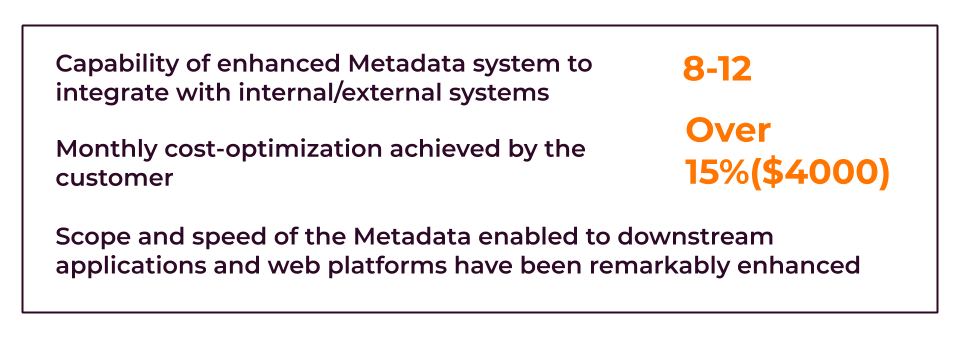The Group Company is a leading content and consumer group in Malaysia and Southeast Asia with a focus on four pillars, namely, watch, listen, read, and shop. The company had an existing Metadata System (MS), which they wanted to redevelop and enhance to meet the requirements. They also wished to rewrite the entire code using open-source technologies.
The existing system faced performance issues that were affecting the user experience and required a fix. Owing to the business needs, this system required a major enhancement to new features, enabling single sign-on, ability to integrate with more internal/external systems using RESTful APIs.
The company also wanted to roll out new features at a fast pace by leveraging Agile / Scrum Delivery Methodology and setting up an automated DevOps pipeline over the Amazon Web Services (AWS) Cloud infrastructure. The customer also wanted to leverage AWS for its benefits like managed infrastructure, application services, scalability and fault tolerance.
Solution Offered by Blazeclan to Meet the Customer Requirements
It started by helping the customer understand the overall Total Cost of Ownership (TCO) of using AWS.
Blazeclan’s product development offering comprised of:
-
An extensive study by our team of certified SAs began to understand the existing code and the system.
-
The new system was rewritten and developed capitalizing on open-source technologies like Linux, MySQL, and Java spring, and Nginx Tomcat.
-
Brainstorming sessions were conducted to scope out new features that can enhance the system.
-
Micro Services Architecture was used to develop independently deployable, small and modular services to achieve a loosed coupled and scalable architecture.
-
Active Directory was integrated to ensure that the users can seamlessly login using their existing credentials.
-
The public RESTful APIs enabled the metadata to be available to many downstream applications and web platforms.
-
UI/UX development process became an integral part of the project as the system catered to more than 150 users. The team understood the user requirements, created prototypes, rinsed and refined and developed the UI.
For a media organization, a metadata system is like a lifeline as it provides metadata to all other downstream applications like VoD and OTT platforms. This application provided a platform for organizing the metadata of media content and resulted in the accomplishment of following key functions:
-
Ingest linear schedules and non-linear products.
-
Verify existing data is correct and meets the company’s standards.
-
Link matching titles across multiple channels/products.
-
Enrich metadata both manually and against external sources.
-
Index the data for faster search.
The Strategy Employed for Smooth Implementation of the Solution
Blazeclan approach ensured to take advantages of:
-
Cloud-Native Application that allows the developer to build loosely coupled web application architecture and utilize services like Amazon Cloud Search, SQS, SNS, S3, and RDS to build a highly scalable and fault-tolerant architecture.
-
Micro Services Architecture to develop independently deployable, small and modular services to achieve a loosed coupled and scalable architecture.
-
Agile methodology for the development process helped in breaking down the project into shorter sprints and in turn ensured continuous feedback at each step from the customer. The progress was tracked and reported by using the latest project management tool JIRA. Scrum practices like sprint planning sessions, stand-up calls, demo, retrospective sessions were conducted during the project delivery.
-
Security Testing of the application ensured zero vulnerabilities (VAPT – Vulnerability Assessment and Penetration Test).
-
Operational Excellence: With a view to reviewing every aspect of the application for quantitative project management, the operational reports are shared on a weekly basis to all the stakeholders. In this process for weekly reporting, we focus on Server Health Monitoring.
Key Benefits Gained by the Customer
-
Improved Performance: Customer experience increased as the redeveloped application provided better performance than the previous one.
-
Scalability: They achieved the ability to scale the application as and when required by leveraging auto-scaling and load balancing features of AWS.
-
Reduced Cost: The Company was able to decrease its operational costs considerably by migrating to AWS.
-
Fault Tolerance: They were able to achieve a fault-tolerant architecture.

Tech Stack
|
Linux |
Java Spring |
MySQL |
|
jQuery |
Nginx Tomcat |
Amazon EC2 |
|
Amazon ELB |
Amazon IAM |
Amazon S3 |
|
AWS Cloud Search |
Amazon SQS |
Amazon SNS |
|
AWS Step Functions |
AWS Lambda |
AWS VPC |
|
Route 53 |
Amazon RDS |

























